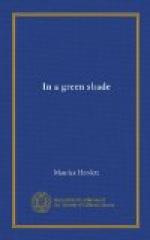Madame de Sevigne, meantime, is in a discomfort of her own. It takes her some ten days to absorb the petite personne, but then she fixes her for ever. Nobody can wish to know more about a young party than this:
“Christmas Day (1675).... I still have that nice child here. She lives on the other side of the park; her mother is the good-wife Marcile’s daughter—but you won’t remember her. The mother lives at Rennes, but I shall keep her here. She plays trictrac, reversis; she is quite pretty, quite innocent, and called Jeannette. She is no more trouble than Fidele.”
Quite pretty, quite innocent and called Jeannette! Quid Plura? Need I say who Fidele was? Fidele is a shrewd touch of Madame’s, put in, as I guess, to placate the hungry-eyed Goddess of Grignan; but it does clinch the portrait. All that one needs to know of the nature, parentage, and upbringing of a petite personne is in these two letters.
Immediately upon her entry the comedy begins, with Mademoiselle du Plessis in a leading part. “... La Plessis has a quartan fever. It is pretty to see her jealous fury when she comes here and finds the child with me. The fuss there is to have my stick or muff to hold! But enough of these nothings....”
It was of nothings that the vexed days of Mlle. du Plessis must exist. An elderly virgin, evidently; stiff, gauche, full of guinderie, says Madame, “et de l’esprit fichu.” Everybody made game of her at Les Rochers. As we shall see, the servants knew that very well. Charles is always witty at her expense. Madame de Grignan once slapped her.
Meanwhile, here’s another vignette, a Chardin picture—you will find nothing by Greuze of this petite personne. “... What do you think of the handy little lady we were telling you of, who couldn’t make out what the day after Easter Eve was? She is a dear little rosebud of a thing who delights us.”
“‘In six years to come she’ll be twenty years old!’ I wish you could see her in the mornings, eating a hunk of bread-and-butter as long as from here to Easter, or, after dinner, crunching up two green apples with brown bread....”




